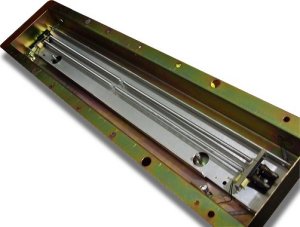About Spring Reverb
 A spring reverb is a system to obtain
artificial reverberation invented during
the 40's by Laurens Hammond (also
inventor of the Hammond Organ). In a
Spring Reverb pan, the audio signal is
coupled to one end of the spring by a
transducer (a device that can convert
electrical energy into mechanical energy
or viceversa). This creates waves that
propagate through the spring in both
directions. At the other end of the spring
there is another transducer that
converts the motion in the spring into an
electrical signal, which is then amplified
and added to the dry sound. Most spring
reverb units use several springs
together, with each spring having its
own characteristics (length, dimensions,
tension, etc.) resulting in a natural
reverberation by summing several delayed sounds at fixed or random intervals. However, with
real spring reverbs the user isn't allowed to change these characteristics. A software simulation
like Type4, on the other hand, allows you to adjust parameters like "decay" (reverb duration),
the dampening factor, the virtual spring tension and other parameters that affect the overall
timbre of the reverb effect.
Why should you want to use a spring reverb rather than a precise and modern digital reverb?
Spring reverbs have typical sonic characteristics that, nowadays, make them desirable mostly
as effects on their own rather than simulations of an acoustic phenomena.
A spring reverb is a system to obtain
artificial reverberation invented during
the 40's by Laurens Hammond (also
inventor of the Hammond Organ). In a
Spring Reverb pan, the audio signal is
coupled to one end of the spring by a
transducer (a device that can convert
electrical energy into mechanical energy
or viceversa). This creates waves that
propagate through the spring in both
directions. At the other end of the spring
there is another transducer that
converts the motion in the spring into an
electrical signal, which is then amplified
and added to the dry sound. Most spring
reverb units use several springs
together, with each spring having its
own characteristics (length, dimensions,
tension, etc.) resulting in a natural
reverberation by summing several delayed sounds at fixed or random intervals. However, with
real spring reverbs the user isn't allowed to change these characteristics. A software simulation
like Type4, on the other hand, allows you to adjust parameters like "decay" (reverb duration),
the dampening factor, the virtual spring tension and other parameters that affect the overall
timbre of the reverb effect.
Why should you want to use a spring reverb rather than a precise and modern digital reverb?
Spring reverbs have typical sonic characteristics that, nowadays, make them desirable mostly
as effects on their own rather than simulations of an acoustic phenomena.
Plugin Description
Type4 is a simulation of a vintage "Type4" spring reverb unit.
Main features:
- Four virtual springs with variable tension
- Variable decay length
- Variable dampening factor
- Adjustable pre and post filtering
- Adjustable timbre
- Very low memory and CPU power needed
- Easy MIDI-Learn feature
|
